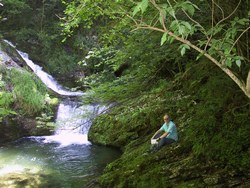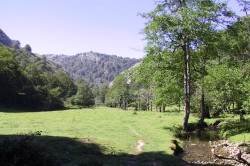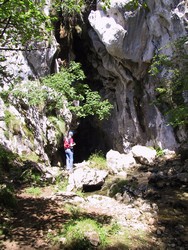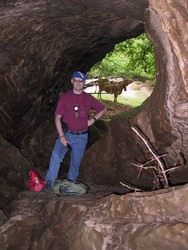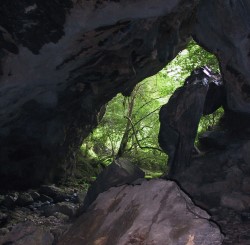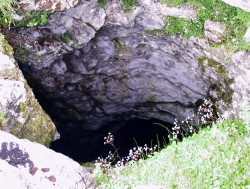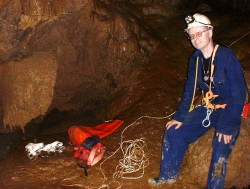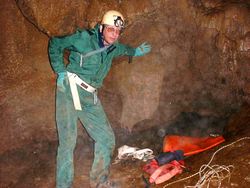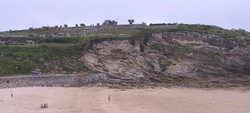

Introduction
Site list (GPS fixes) Walks (GPS tracks) Video clips Panoramas
Electronic projects:
Bat detector
Lamp tests
µ-controlled lamp
SEPIC-based lamp
ISP isolators
Making SMT boards
Expedition logs:
Spain 1973, 1974,
1975, 1976, 1977,
1979, 1982, 1983,
1985, 1986, 1987,
1988, 1989, 2000,
2001, 2002, 2003,
2004, 2005, 2006,
2007, 2008, 2009,
2010, 2011, 2012,
2013, 2014, 2015,
2016, 2017, 2018,
2019, 2020, 2021,
2022, 2023
Mexico
New England
Translation:
Expedition log, Summer 2001
A summary and index of the Speleogroup logbook.
Cubilla, El Mazuco, Orandi, Viango, Pozo del Infierno, etc.
| Date | Activity |
|---|---|
| 19.07 | Bill & Mike meet at the (brand new) Bilbao airport as planned, about
15:00. To Castro Urdiales to check in (Hostal Vista Alegre), then
off to the caves to measure and verify altitudes (see below). We soon confirm that the cave previously known in the OUCC
logs as Penilla is in fact called Cubilla, so all previous write-ups
have it wrong! Further, on exploration, the ‘survey’ turned out
to be rather misleading: we instantly found a major inlet series
on the right after entering the cave (close to the entrance, and
with Spanish(?) survey mark F7) – at least 150m of passage with +48m
vertical range. There was also no hint that the main passage is
steeply descending – a range of 55–70m! So the first day’s caving
turned out to be a bit more strenuous than planned – and ordinary
clothes were not a good idea (although we got surprisingly far down
the cave: −70m).
We also noted that the water in the main passage could all be accounted for by the flow from inlets, so it is unlikely to be the main stream rejoining as shown on the survey (which is completely unaccounted for). This is confirmed by the deposit of “tufa” in the streamway, which shows that the water is derived from inlets, not the surface stream. Our limit of exploration was down a white tufa boss to a deep pool; excellent grip made the climb easy. Back to the hotel to clean up, then into Castro for a hearty meal (setas con jamón, chuletillas de cordero, bonito, etc.). |
| 20.07 | The journey to Llanes on the toll-free autopista is about 2 hours, not including a brief stop at San Vicente de la Barquera for a plate of Tortilla & Anchovies.
Checked into Hotel Las Rocas and then off towards El Mazuco via Pareda. Stops to investigate depressions near K6 and to admire the view at Alto de la Tornería. Drink in the El Mazuco bar, where the owner remembers OUCC visits (1969–71) as a boy and confirms that the Cueva de Viango is small. A long route takes us down to Cueva del Bolugo, a splendid sink in a cliff face complete with rickety bridge and the remains of the old generator hut (which generator was famously repaired by OUCC in the old days). The foaming streamway looks very exciting. A direct, even hotter, but not very obvious, route takes us back to the bar and refreshment. Into the car and on down to Caldueñín for a quick photographic trip to the entrance, where the underground river is met almost immediately. Next to Cortinas where a friendly local shows us the gated entrance to Nacimiento de Río (key held by Asturagua in Llanes). Back to Llanes via Posada/Acuario. Dinner (menú del día) at Uría circa 9:30pm (fabada, lomo, truchas). |
| 21.07 |
Drove to Orandi noticing the poster advertising a fiesta at Rales
tonight. We parked in the shade on the busy road up to the lakes
(+480m).
We were surprised at our fast progress up to the saddle which the altimeter confirmed to be 615m and therefore close to the Orandi sink (we were at El Arniu). Down through the beech woods with exotic funghi (and cowsh) to the delightful blind valley of Orandi (see picture). A diversion “upstream” failed to find the higher spring marked on the map. Pretty easy walking at the valley floor level. Down to Orandi entrance (500m) to confront a wary bull, warily skirted. Clambered into the cave, took photos. In flood there are further sinks downstream – all clogged up with mud. The whole valley bottom is a delightful meadow, with a ‘lost valley’ effect as the water sinks at the end. Back to the car in the heat (the uphill thankfully in the woods and thus shaded). Then via Covadonga and Cangas to Ribadesella for an excellent lunch in a new (to us) restaurant (soup, paella, merluza, escallopines). Indulged in some Manchego and Cabrales. Back to Llanes, stopping at Rales to determine details of the fiesta. Eventually to El Retiro (via Parres, as Llanes through route closed for fiesta) for a light supper of patatas bravas and Cabrales. Then on to Rales. Nobody recognisable at the village square so we move to María José’s garden; we looked at the old photographs in the 1973+ album – four of the young men from then are now dead! (Paco, Manolo..., all due to accidents). María and daughter Patricia then took us to Tony & Juanjo’s house where chops & sausages were offered and eaten. |
| 22.07 | Sunday, Fiesta de la Magdalena, so the town (Llanes) is packed. Woken by (very) loud maroons. Festering day, the main challenge turns out to be trying to find a restaurant for lunch which is not fully booked. Watched parade of “large corn dollies” then tried some out-of-town restaurants. Eventually ended up at Ribadesella again. Slow return to Llanes via back roads through Rales, and Café Moderno in Posada.
Dinner at Uría (tuna omlette, lomo/sardinas), followed by a walk to El Brau and back by the beach road. Centre of town all set up with stalls, music stage, etc. Loud music until well past 4am. |
| 23.07 | Breakfast at 8:30 and a drive up to Alto de la Tornería, 463m. Start walking up cemented track at 10:00. This bit was easy! Track suddenly becomes a path at the first saddle. We see the main W–E valley after 20 minutes.
As Bill’s gut was playing up rests were frequent!
We reached the big flat basin of the Yosa del Viango at 12:00 and
we found the Cueva amid trees and cows on the south west side. The
whole Yosa is one sand deposit. Surprisingly the cave, at 390m,
is open and progress from a large 3m+ entrance leads to the ways
on. Above a larger passage leads to a 2m climb (not descended).
Down leads to a crawl. Explored length 20m, vertical range 5m [see
2003 for full exploration].
Mike then explored up the S. wall of the valley (as much to test the PMR446 radios as anything). 3 or 4 sinks, all silted up. Opens up into a wide water channel, long dry, with sand scarps. Radio short range warning at about 400m, long range at ~1km (line of sight) – a little disappointing. In the centre of the valley is a large pool, with scattered animals around (mules, cows, horses). After checking out several ‘cow shelter’ caves on the north side of the valley, Bill made friends with a local horse, and we left the valley at about 13:15. Good progress back was made until we found ourselves on an ascending path and decided to take the more direct route back to Tornería shown on the map. Unfortunately all signs of the path petered out near the first peak, the mist came down, and we were forced to retreat down the side of the hill to rejoin the original path. Much rough limestone and many grikes were crossed, in a ‘classic’ struggle... Eventually get back at the car at 15:30; 5½ hours walking. Bill feels stiff all evening. Early dinner at Siete Puertas; soup for Bill, escalope for Mike. An early night. |
| 24.07 | Shopping, bank. Then east to Suarías (near Panes) via the inland route. A 28-minute tinto (slow service) then up the mountains to
Cabañuca and also up the new track beyond. Back to the depression
adjacent to Cabañuca to see if the sink had opened up in the 25
years since Bill’s last visit in 1973. (It hadn’t.)
[Cabañuca location: Take the track/road east out of Suarías past the cow trough on the right and up the mountain, then after ~500m turn left (near small quarry) and down for 200+m. A closed valley on the left (altitude ~315m) conceals the 5m high entrance to Cabañuca. The main/big depression containing the inpenetrable sink is on the right at this point.] On to La Hermida for a light lunch, and then a thorough exploration of the nearby derelict old hotel and spa, with its early 20th century signal and lighting wiring. Bats in the attic! (By now c. 5pm.) Then to LaFuente, where sadly the old bar no longer exists. Next stop Toyu (now signposted Sumidero de Toyo) to photograph the entrances. The upper entrances quite easy to find near barn; the route to the main sink much harder, with several precarious stream crossings. After photos took the (very much) quicker route back to the road through a smallholding. Back to Llanes via Unquera to clean up and a late supper (escalope at 10:30). |
| 25.07 | This year being the 25th anniversary of Forcau ’76,
it was time to head for the mountains.
Up to the Lakes (Los Lagos) via autovía to Llovio, stopping only to buy two small bottles of water at the exorbitant price of 300pts. We couldn’t recognise the path to Trumbio on the way up, so without stopping we proceeded to lake Ercina and the María Rosa bar for a tinto and a Kas at 11:00. Some GB vehicles turned out to be cavers’, guarded by John Wilcock of 1961 OUCC fame. After a chat, we started off for Forcau at 12:15 as the mist came down. Careful map- and compass-work by Mike ensured good route finding. Frequent stops to rest, photograph, and gulp water delayed our arrival at Forcau til ~14:30. We took the route via Vega Ceñal and El Forcau (east) as although this required extra climbing it arrived very close to the pot. Pozu de Vega El Forcau, it turned out, is exactly where it is shown on the latest maps: down-slope and a little further away from El Forcau (the walking path pass) than the stone walls/pens. After inspecting the aged bolts and sleeves, took photographs and returned down-valley. The mist which had conveniently cleared at Forcau (+1500m) soon came down again, so we used bearings to rejoin the main route and then descend to El Tolleyu – a small cluster of cabañas by a dry trough. From there an easy descent to the large Vega El Paré and then the usual (only) route down to the lake. Total time about 4 hours, including stops. 400m ascent. The car park and bar now very busy, but we had little difficulty consuming a plate of salty queso with tinto/Kas. Eventually returned to Llanes after a short chat with John Wilcock. Dinner at restaurant near the hotel ~9:30pm, after surviving 25 minutes of continuous air-raid sirens at 7pm as a statue was paraded to the church. |
| 26.07 | First stop after breakfast is the Purón valley to investigate hydrology, and a resurgence cave which Bill had visited in ~1985. We parked in the “usual” spot between the two halves of the village and betwen two rivers, close to a bridge. Walked 100m up middle path to mill and rejoined track. A local took us to a cave, El Cuelebre – which was the one we were looking for; apparently it was used as shelter during the Civil War, presumably during the battle of El Mazuco. Explored for 5m – meandering stream in a muddy environment. The cave continues.
To Purón bar, then a walk around on La Franca beach. Lunch at recommended Casa Pancho in Puertas de Vidiango (cecina, chorizo, patatas, good tinto! 900pts each). [Just in time, it turned out; it was partly demolished by a lorry a few months later and not rebuilt until 2009.] Whiled away the rest of the day with walks near Llanes and dinner near the hotel. Then off to the Naves fiesta Multiple stages and loud music but somehow disappointing. Returned around midnight. |
| 27.07 | Now ‘warmed up’ – it’s time for some serious caving.
Objective Pozo del Infierno. After a quick shop, a prompt start
for the Deva Gorge, via Bustio and Panes, and we are soon at the
Coto de El Infierno.
Decided to change at the bottom of the hill. Although this meant very sticky climbing it proved to be the right thing to do, because the ‘path’ was badly overgrown with bracken, brambles, gorse, hawthorn, holly ... Climbing was hard work – +200m in a very short disatnce through hostile brush, using trees as landmarks. Eventually crossed the ridge a little high, but almost level with the entrance to cave, which was then easy to find at 264m. The actual entrance is in a kind of irregular conglemerate. Just inside is a false floor sloping down into a big chamber decorated with large stalagmites and stalactites. The first muddy ramp, immediately inside the conglomerate entrance, was rigged with an 18m rope, with just 3m to spare. The rope could be used just as a handline but using a descender seemed safer, given everything rather slippery. Some steps on the right. Bearing right at the bottom of the ramp takes one to the first chamber of stal. On through this large chamber to the far end, where an easy ascent of a couple of metres between two rounded stalagmite bosses leads eventually to the top of the second, near-vertical, ramp. This is effectively a 10m pitch and we treated it as such; we used a 20m rope belayed from a higher stal boss at the ledge overlooking the ramp. Leaving most of our gear at the bottom (see pictures), the way on is a climb which regains the height just lost, with good grip and handholds on the right. Soon in a huge muddy chamber, over 30m high (ceiling height), with mudslides. A tiny inlet has cleaned some of the rock. Vast stalagmites evocative of statues and fists. The water trickle leads to the Tubo del Viento, which draughted (weakly); a wettish thrutch. At the bottom a slightly exposed climb (handline reassuring) leads up and on to the Sala del Riu (River Chamber), with a beautiful clear deep blue inlet sump and clean, almost black, rocks. The water sinks in a boulder ruckle. A rope hanging some 10m up the water chamber confirmed the way on (which we had ascended in 1975). Lacking jammers (left at the bottom of the 2nd ramp) we decided not to risk the ascent (we never expected a rigged pitch!). The rope was marked G.E.S. 18,77. Nevertheless satisfied with the progress achieved, we proceeded out with even greater speed than the descent. Jammers with footloops used on the ramps with success. About 3 hours in the cave; 45 minutes down the hill compared to 90 minutes up. |
| 28.07 | Quiet day to recover; washed ropes. Bill visits Rales to arrange appointment with dentist, etc., while Mike explores the outer streets of Llanes. Lunch in Llanes then off to El Mazuco to re-check the altitudes of the water course; discovered that in low water conditions Cueva del Caldueñín can be explored for “some distance”.
See table below for logged altitudes.
Bill had discovered in Rales that Antonio – 1973 caver from Rales – now runs a Mexican restaurant in Llanes, which we hadn’t tried. So, pizza and tacos for supper. Thus inspired, after supper we went to the old Talleru (now called Abezu) for a Piña Collada; nice, but slow in arriving as they had to go next door to get it...! |
| 29.07 |
Inland to Arenas where we inspected cheeses and successfully tracked
down a cow bell with just the right sound.
Back via Posada in very humid weather, then general packing up, etc. Mike does a photo tour of Llanes for the digital record. Dinner at Casa Poli in Vidiago. Raciones of revuelta de setas, calamares, croquetas. Good tinto ‘Protos’. |
| 30.07 | Posada at 09:30 for a dental checkup for Bill, then straight east to Castro (via Vargas). Lunch in Hostal Vista Alegre.
Our last reconnaissance ... Cueva de Sangazo ≡ La Lastrilla. Drove past La Cubilla to 4km track to explore on foot a depression (near Linares) taking a stream. No open cave, but a secondary sink had a good draught (good dig). Tadpoles! Hill fort? Expedition dinner at end of Castro promenade/square. |
| 31.07 | Tuesday. 8am breakfast before leaving for Bilbao airport. Fiesta day so almost no traffic, though humid, still, and massive pollution trapped in the industrial areas. A 40 minute drive from Castro to the new Bilbao airport.
Mike’s flights uneventful – but yet again his bag of caving gear goes AWOL on the way back to BHX, arriving the following day. Bill returned to check for more caves near Castro, unsuccessfully – so retired to the Gugenheim museum for the afternoon!. |
Personnel: Bill Collis & Mike Cowlishaw.
Other log details:
Altitude readings 19 July 2001, adjusted for sea level at 19:30:
| Sangazo | 62m | |
| Saddle | 178 | |
| Cubilla col | ~210 | |
| Car parking | 195 | (by track to cave) |
| Cubilla | 90 | (lowest point reached) |
| Cubilla | 187 | (highest point reached) |
| West inlet | ~140 | (lowest point) |
| Top of Penilla track | 227 | |
| Cubilla Entrance | 155 |
Altitude readings 28 July 2001, adjusted for sea level at 19:47:
| Place | uncorrected | adjusted |
| Alto de Tornería | 475m | 450m |
| Bar El Mazuco | 362 | 337 |
| Caldueñín | 165 | 140 |
| Villa | 244 | 219 |
| Cortines bridge | 130 | 105 |
| El Sucón bar | 120 | 95 |
| Posada | 58 | 33 |
| Sea at Playa Toró | −25 | 0 |
